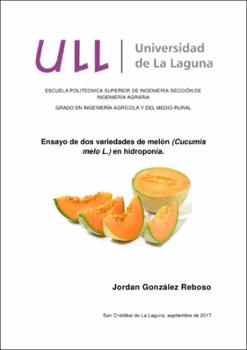Ensayo de dos variedades de melón Cucumis melo L. en hidroponía
Autor
González Reboso, JordanFecha
2017Resumen
Este Trabajo de Fin de Grado es un ensayo de dos variedades de melón
(Cucumis melo L.) tipo Cantalupo de un cultivo sin suelo bajo condiciones de
invernadero de cristal. La siembra se hizo en bandejas de poliestireno
expandido, utilizando como sustrato fibra de coco. Los cultivares ensayados
fueron: Charentais y Picasso. La fase de sustrato transcurrió con normalidad y
se obtuvo un porcentaje de germinación 100% en Picasso y 94% en
Charentais. Posteriormente se trasplantaron las plántulas a fibra de coco,
siguiendo un diseño de bloques al azar de tres repeticiones con plantas bordes.
Las plantas se alimentaron mediante una solución nutritiva NPK 12-1,5-7 ,
Según, (Santos Coello,B y Ríos Mesa,D, 2017).
Al final del cultivo se procedió a realizar la recolección y a la toma de datos
de los parámetros necesarios para la evaluación agronómica: peso, diámetro,
longitud, grados brix y rendimiento.
Estos datos se procesaron estadísticamente. Se hizo un análisis de varianza
y T de Student.
Como consecuencia de este análisis se puede decir, que en las condiciones
de este ensayo, la variedad Picasso dio diferencias significativas respecto a
Charentais respecto al peso, diámetro, grados brix, longitud y rendimiento. This Work of End of Degree is a test of two varieties of melon (Cucumis melo
L.) type Cantalupo give culture without low soil conditions of greenhouse of
crystal. The sowing was done in trays of expanded polystyrene, using as
substratum fiber of coconut. You will cultivate them tested they were:
Charentais and Picasso. The phase of substratum passed with normality and
100 % obtained a percentage of germination in Picasso and 94 % in
Charentais. Later transplanted the seedlings to coconut fiber, following a design
of blocks at random of three repetitions with plants embroider. The plants fed by
means of a nourishing solution NPK 12-1,5-7. According, (Santos Coello,B y
Ríos Mesa,D, 2017).
At the end of the crop proceeded to carry out the collection and gathering the
necessary parameters for the agronomic evaluation data: weight, length,
diameter and brix and yield grades.
These data were statistically processed. An analysis of variance was made
and T of Student.
Since consequence of this analysis it is possible to say, can be said that
under the conditions of this test, the variety Picasso gave Charentais significant
differences with respect to weight, diameter, length, brix degrees and
performance.




